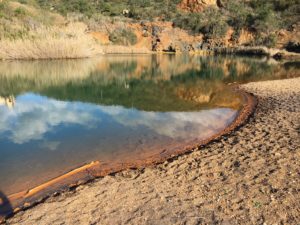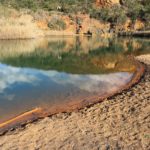- Created: 18 Novembre 2017 20:29
- Updated: 3 Aprile 2018 20:48
- Distance Instructions
- Distance 2 km
- Time 0 s
- Speed 6.0 km/h
- Min altitude 0 m
- Peak 0 m
- Climb 77 m
- Descent 82 m

Il sentiero n. 223 collega, passando dalla spiaggia di Reale, la spiaggia di Barbarossa al laghetto di Terranerra; ha una lunghezza di circa 2 km e si percorre in circa 25 minuti. Dalla spiaggia di Barbarossa si inizia salendo mediante una scalinata; il percorso è poi pianeggiante e facilmente percorribile, si snoda lungo la costa nei pressi di una delle aree minerarie elbane di maggior fascino paesaggistico, significato naturalistico ed interesse storico. Lungo il fosso di Reale, si apre la Grotta dell'Orso delle Caverne, attualmente non visitabile ; nella zona sono segnalati ritrovamenti di industrie litiche dell'Età della Pietra, provate a fare un salto indietro nel tempo di ben 2,5 milioni di anni (Paleolitico inferiore- Medio), all'epoca in cui l'Uomo ha iniziato a lavorare le pietre per produrre utensili, un'utilizzo che sotto altra forma è continuato fino ai tempi moderni con l'estrazione dei minerali ferrosi. Davanti alla spiaggia di Terranera, quando si dragavano le sabbie ferrifere, non erano infrequenti i ritrovamenti di chiodini in rame, ceramiche e pezzetti di pasta di vetro grigio. Trovare qualche reperto sarà difficile, provateci lo stesso, di certo potrete ammirare l'esplosione dei colori delle diverse rocce. Vi trovate in un vero e proprio paradiso per gli appassionati di geologia e mineralogia. La comprensione dell'evoluzione geologica di quest'area è tanto interessante quanto complicata a causa della difficoltà per ricostruire i movimenti che hanno portato i vari strasti rocciosi nella posizione attuale. Più semplice identificare i diversi minerali. In particolare si può osservare l'ematite di colore scuro, uno dei principali componenti della sabbia della spiaggia del Laghetto, presente qui anche con una sua particolare varietà denominata oligisto. L'altro tipico minerale del ferro che potete riconoscere è la pirite, dal colore giallastro per il quale è conosciuta come l'oro degli sciocchi. La posizione del Laghetto di Terranera lo fa sembrare un laghetto costiero in realtà la sua origine è mineraria, si è infattin formato a seguito del riempimento di un pozzo minerario con acqua solforosa, che si è poi diluita con acqua salmastra proveniente delle vicine acque marine. Il risultato è uno spettacolore color verde. Dall'attigua miniera venivano estratte, un tempo, ematite, pirite e magnesite. La balneazione nel laghetto è vietata per motivi di sicurezza.
Path n. 223 connects the beach of Barbarossa to the Terranerra lake passing by Reale beach ; it is about 2 km long and takes around 25 minutes. From Barbarossa beach you climb up some stone stairs and then the path is flat and easily walkable. It winds along the coast near one of the most interesting mining areas of Elba where the landscape is full of naturalistic and historic significance.
Along the Fosso di Reale, lies the Grotto of the Cave Bear, (currently not open to visitors (???). In this area there are reported to be Stone Age industrial remains, this is a leap back in time of 2.5 million years (Lower Paleolithic - Medium), at the time when Man began to work with stones to produce tools, a practise that has continued until modern times with the extraction of ferrous minerals. In front of Terranera beach, whenever the iron sands were dredged, it was common to find bits of copper nails, ceramics and small pieces of gray decorative glass. Trying to find some remains will be difficult now, but anyway you can certainly appreciate the explosion of the amazing colours of the different rocks in this area.
You are in a real paradise for geology and mineralogy enthusiasts. The understanding of the geological evolution of this area is as interesting as it is complicated due to the difficulty in reconstructing the movements that brought the various rocky layers into their current position. Easier to identify are the different minerals. In particular, there is a dark-coloured hematite, one of the main components of the sand of Terranerra beach, alongside is another distinct variety called oligistum. Another typical mineral is the iron ore that you can easily recognize as pyrite, known as Fool’s Gold because of its yellowish colour. Due to its position, Terranera Lake seems like a small coastal lake. In fact, its origin comes from mining. It was formed following the filling of a mineral well with sulphurous water, which was then diluted with brackish water coming from the nearby sea and as a result it is a spectacular green colour. Hematite, Pyrite and Magnetite were once extracted from the adjacent mine. Bathing in the lake is forbidden for safety reasons.
Der Weg Nr. 223 verbindet die Strände von Reale und Barbarossa zum See von Terranerra; ist zirka 2km lang und man kann es in 25 Minuten gehen. Vom Strand von Barbarossa führt eine Treppe hoch, dann ist der Weg flach und einfach, man lauft an der Küste entlang in einer der faszinierenden Teil der Mineralien Area von Elba, sowohl für die Natur als für die Geschichte. Am Fluss von Reale entlang befindet sich die Grotte genannt „Baer der Höhlen“ (im Moment nicht zu besichtigen) eine Fundstelle von der Steinzeit; versuchen Sie bis zu 2,5 Millionen Jahre zurück zu gehen (Früh-Mittel Paläolithikum) in der Zeit wo man die Steine als Utensilien bearbeitet hat, danach die Gewinnung von Eisenmineralien ist bis zu moderne Zeiten weitergegangen. Vor dem Strand von Terranera bei dem Ausbaggern von Eisen Sand, fand man oft Nägel aus Kupfer, Keramik und Graue Glasscherben. Fundstücke zu finden wird schwierig sein, aber versuchen Sie es doch, einfacher ist die Farbenexplosion in den Steinen zu bewundern. Es ist ein Paradies für die Begeisterten von Geologie und Mineralogie. Dunkle Hämatit genannt „Oligisto“ ist der prinzipielle Bestandteil vom Sand des Strandes von Terranera. Pyrit ist ein typisches Eisenmineral aus Goldfarbe wird auch „Katzengold“ genannt. Dieser See ist kein Küstensee, sondern eine Minengrube die mit Schwefel Wasser gefüllt wurde und dann mit Meereswasser verdünnt wurde. Das Resultat ist ein Wasser von wunderschöner grüner Farbe. Aus der Mine wurde in früherer Zeit Hämatit, Pyrit und Magnesite gewonnen. Aus Sicherheitsgründen darf man im See nicht baden.

Il sentiero n. 223 collega, passando dalla spiaggia di Reale, la spiaggia di Barbarossa al laghetto di Terranerra; ha una lunghezza di circa 2 km e si percorre in circa 25 minuti. Dalla spiaggia di Barbarossa si inizia salendo mediante una scalinata; il percorso è poi pianeggiante e facilmente percorribile, si snoda lungo la costa nei pressi di una delle aree minerarie elbane di maggior fascino paesaggistico, significato naturalistico ed interesse storico. Lungo il fosso di Reale, si apre la Grotta dell’Orso delle Caverne, attualmente non visitabile ; nella zona sono segnalati ritrovamenti di industrie litiche dell’Età della Pietra, provate a fare un salto indietro nel tempo di ben 2,5 milioni di anni (Paleolitico inferiore- Medio), all’epoca in cui l’Uomo ha iniziato a lavorare le pietre per produrre utensili, un’utilizzo che sotto altra forma è continuato fino ai tempi moderni con l’estrazione dei minerali ferrosi. Davanti alla spiaggia di Terranera, quando si dragavano le sabbie ferrifere, non erano infrequenti i ritrovamenti di chiodini in rame, ceramiche e pezzetti di pasta di vetro grigio. Trovare qualche reperto sarà difficile, provateci lo stesso, di certo potrete ammirare l’esplosione dei colori delle diverse rocce. Vi trovate in un vero e proprio paradiso per gli appassionati di geologia e mineralogia. La comprensione dell’evoluzione geologica di quest’area è tanto interessante quanto complicata a causa della difficoltà per ricostruire i movimenti che hanno portato i vari strasti rocciosi nella posizione attuale. Più semplice identificare i diversi minerali. In particolare si può osservare l’ematite di colore scuro, uno dei principali componenti della sabbia della spiaggia del Laghetto, presente qui anche con una sua particolare varietà denominata oligisto. L’altro tipico minerale del ferro che potete riconoscere è la pirite, dal colore giallastro per il quale è conosciuta come l’oro degli sciocchi. La posizione del Laghetto di Terranera lo fa sembrare un laghetto costiero in realtà la sua origine è mineraria, si è infattin formato a seguito del riempimento di un pozzo minerario con acqua solforosa, che si è poi diluita con acqua salmastra proveniente delle vicine acque marine. Il risultato è uno spettacolore color verde. Dall’attigua miniera venivano estratte, un tempo, ematite, pirite e magnesite. La balneazione nel laghetto è vietata per motivi di sicurezza.
Path n. 223 connects the beach of Barbarossa to the Terranerra lake passing by Reale beach ; it is about 2 km long and takes around 25 minutes. From Barbarossa beach you climb up some stone stairs and then the path is flat and easily walkable. It winds along the coast near one of the most interesting mining areas of Elba where the landscape is full of naturalistic and historic significance.
Along the Fosso di Reale, lies the Grotto of the Cave Bear, (currently not open to visitors (???). In this area there are reported to be Stone Age industrial remains, this is a leap back in time of 2.5 million years (Lower Paleolithic – Medium), at the time when Man began to work with stones to produce tools, a practise that has continued until modern times with the extraction of ferrous minerals. In front of Terranera beach, whenever the iron sands were dredged, it was common to find bits of copper nails, ceramics and small pieces of gray decorative glass. Trying to find some remains will be difficult now, but anyway you can certainly appreciate the explosion of the amazing colours of the different rocks in this area.
You are in a real paradise for geology and mineralogy enthusiasts. The understanding of the geological evolution of this area is as interesting as it is complicated due to the difficulty in reconstructing the movements that brought the various rocky layers into their current position. Easier to identify are the different minerals. In particular, there is a dark-coloured hematite, one of the main components of the sand of Terranerra beach, alongside is another distinct variety called oligistum. Another typical mineral is the iron ore that you can easily recognize as pyrite, known as Fool’s Gold because of its yellowish colour. Due to its position, Terranera Lake seems like a small coastal lake. In fact, its origin comes from mining. It was formed following the filling of a mineral well with sulphurous water, which was then diluted with brackish water coming from the nearby sea and as a result it is a spectacular green colour. Hematite, Pyrite and Magnetite were once extracted from the adjacent mine. Bathing in the lake is forbidden for safety reasons.
Der Weg Nr. 223 verbindet die Strände von Reale und Barbarossa zum See von Terranerra; ist zirka 2km lang und man kann es in 25 Minuten gehen. Vom Strand von Barbarossa führt eine Treppe hoch, dann ist der Weg flach und einfach, man lauft an der Küste entlang in einer der faszinierenden Teil der Mineralien Area von Elba, sowohl für die Natur als für die Geschichte. Am Fluss von Reale entlang befindet sich die Grotte genannt „Baer der Höhlen“ (im Moment nicht zu besichtigen) eine Fundstelle von der Steinzeit; versuchen Sie bis zu 2,5 Millionen Jahre zurück zu gehen (Früh-Mittel Paläolithikum) in der Zeit wo man die Steine als Utensilien bearbeitet hat, danach die Gewinnung von Eisenmineralien ist bis zu moderne Zeiten weitergegangen. Vor dem Strand von Terranera bei dem Ausbaggern von Eisen Sand, fand man oft Nägel aus Kupfer, Keramik und Graue Glasscherben. Fundstücke zu finden wird schwierig sein, aber versuchen Sie es doch, einfacher ist die Farbenexplosion in den Steinen zu bewundern. Es ist ein Paradies für die Begeisterten von Geologie und Mineralogie. Dunkle Hämatit genannt „Oligisto“ ist der prinzipielle Bestandteil vom Sand des Strandes von Terranera. Pyrit ist ein typisches Eisenmineral aus Goldfarbe wird auch „Katzengold“ genannt. Dieser See ist kein Küstensee, sondern eine Minengrube die mit Schwefel Wasser gefüllt wurde und dann mit Meereswasser verdünnt wurde. Das Resultat ist ein Wasser von wunderschöner grüner Farbe. Aus der Mine wurde in früherer Zeit Hämatit, Pyrit und Magnesite gewonnen. Aus Sicherheitsgründen darf man im See nicht baden.

